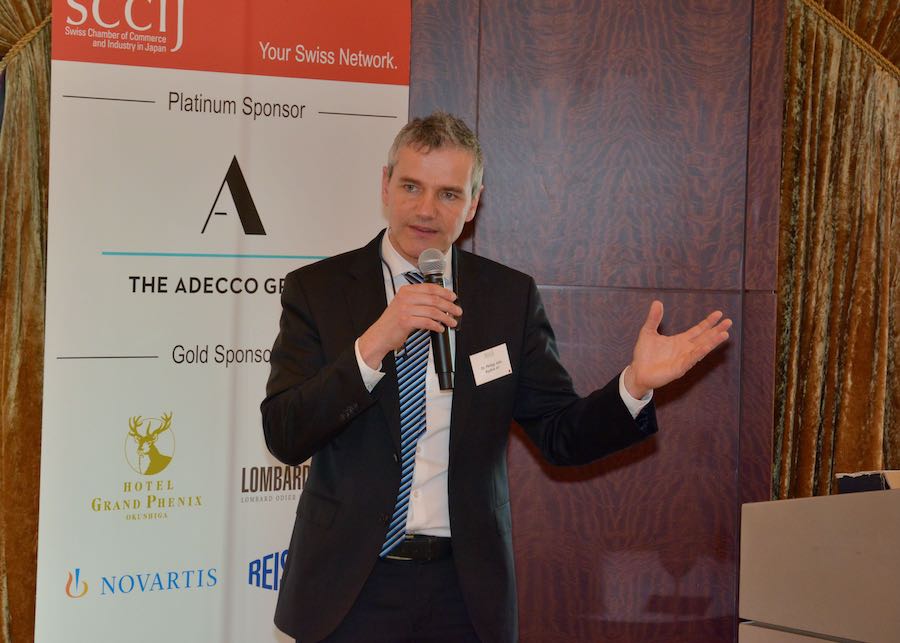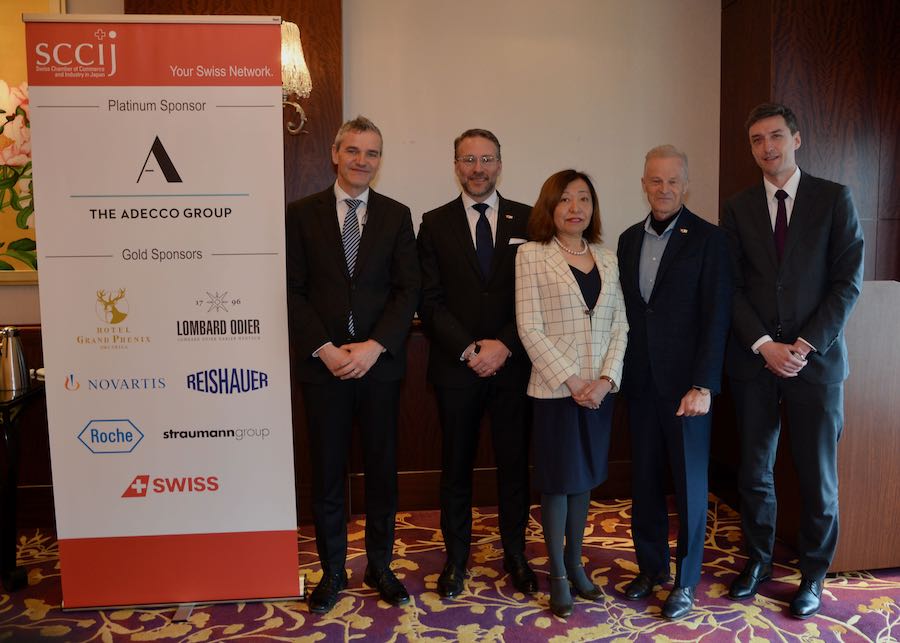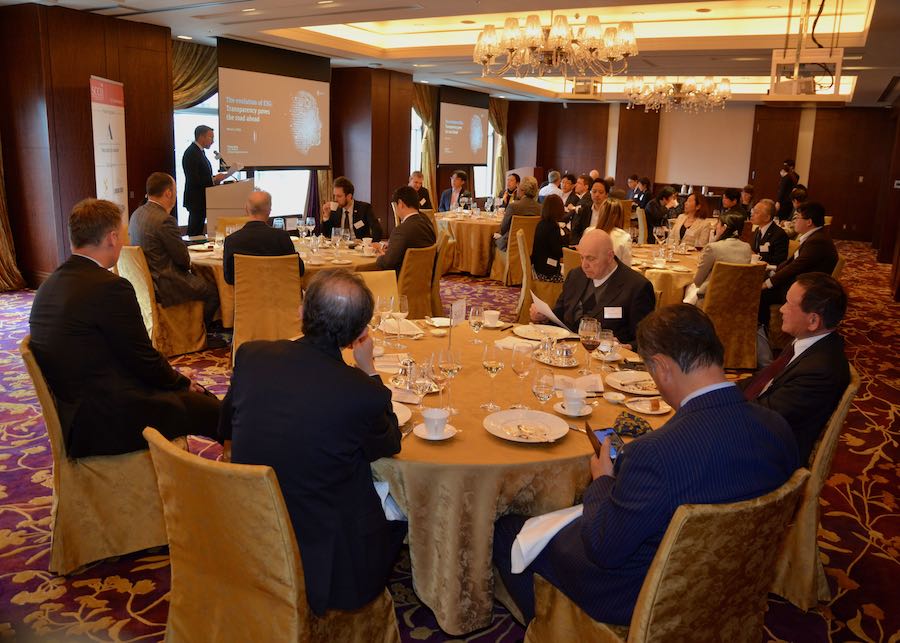Tokyo (SCCIJ) – At the March luncheon attended by 40 members and guests of the Chamber, Philipp Aeby, the Swiss CEO and co-founder of RepRisk, provided insights into the regulatory environment for ESG (environmental, social, and governance) investing and corporate reporting. Below we present the key points of his speech in a Q&A format.

SCCIJ March Luncheon speaker Philipp Aeby of RepRisk.
What is your view on the recent backlash against the concept of ESG investing and reporting?
Philipp Aeby: We need to understand why this is happening. ESG has become a big topic, but frankly, there’s disagreement about what it stands for. In Europe and the U.S., ESG has become a controversial term and has gotten a bad name in some circles. The backlash is a result of a number of issues: actual greenwashing, confusion about the purpose of ESG, dubious claims of the above-benchmark performance of ESG investments based on fake time series, questionable use of data, and lack of transparency in data methodologies.
What are your main concerns?
P. Aeby: One concern is companies that simply do not deliver on their promises, with British Petrol being a prominent example. The oil producer recently backtracked on its pledge to reduce its carbon footprint. They may have their reasons, but the lesson we should all learn is that if you make a promise, it should be credible, and you should keep it. My second concern is that we should look at whether ESG is having a positive impact on society. If you announce ESG targets without real impact, then that can be a kind of mis-selling.
What do you mean by the impact of ESG measures?
P. Aeby: We have to look at what companies are trying to achieve. Do they want to reduce their carbon footprint or protect biodiversity? Or promote social goals such as greater diversity at the board and executive levels? There are often sustainability tradeoffs to consider. If a hotel switches to a soap dispenser in the guest bathrooms, it saves money and reduces plastic waste. This is a win-win for the bottom line and the environment. But a solar power plant that produces fossil-free electricity may at the same time harm nearby plant and animal life. Another example: If the world’s largest cement producer sells part of its business, the company has reduced its carbon footprint and made investors happy, but the total CO2 emissions from cement production remain constant. There is no benefit to the environment.

Members and advisors of the SCCIJ with March Luncheon speaker Philipp Aeby of RepRisk.
What are the key steps in the evolution of ESG awareness?
P. Aeby: About five years ago, no one was looking under the hood of ESG investments, even though the rating methodologies changed often and ESG objectives were unclear and shifting. The data was often back-engineered. Then a December 2018 article in the Financial Times by Kate Allen titled “Lies, damned lies and ESG ratings” drew attention to the problem. The article referenced a recent report that showed there was a lack of correlation between two major ESG rating methodologies that were assessing the sustainability of companies. Soon after, an academic research paper was published that labeled the problem with ESG score divergence “aggregate confusion,” concluding that variance was common, and calling for greater attention to underlying data.
What are the reasons for the high variance between ESG assessments?
P. Aeby: One reason has to do with how you measure something. For example, imagine that you want to qualify for the safety record of a company. You can look at the number of safety incidents, the number of deaths and injuries, and hundreds of other data points that can be aggregated in many different ways to achieve very different results. Another reason has to do with what it is that you’re measuring in the first place. An article in Bloomberg Businessweek in December 2021, “The ESG Mirage,” drew attention to the fact that one of the largest ESG rating providers does not measure a company’s impact on the planet and society. Instead, their rating methodology only looks at the world’s potential impact on the company and its shareholders. This brought a lot of attention to ESG ratings and since then everyone has been much more interested in what is lying under the hood and in understanding ESG approaches and the underlying data.
What about your company RepRisk? What do you do differently?
P. Aeby: We started working for banks to help them with their due diligence processes, so from the beginning, the purpose of our dataset was not to provide ESG ratings, but to identify and assess material ESG risks. On a daily basis, we collect about 500,000+ documents in 23 languages from 100,000 sources such as media, NGOs, think tanks, social media, and regulators. Our scope covers 28 ESG issues in line with key international standards, including cross-cutting issues such as controversial products and services, supply chain issues, and violations of laws and standards. By combining AI and machine learning with human intelligence, we deliver daily updated data on risk incidents happening all over the world. We are very clear about the purpose of our data and metrics, and we are transparent about our research approach and methodology. With such ESG risk data, it is much easier to assess the impact of a company on people and the planet and to identify when companies are greenwashing.

The SCCIJ March Luncheon about “The Evolution of ESG” was fully booked.
Biography of the speaker
Dr. Philipp Aeby is the CEO and co-founder of RepRisk. He is an expert in business conduct risk management with a special interest in machine learning. Before founding RepRisk in 2006, Dr. Aeby held various management positions across Europe at Amgen, a global biopharmaceutical company, and worked on a wide range of international assignments with the Boston Consulting Group. Dr. Aeby holds a Ph.D. in Environmental Physics and a Master’s degree in Climatology and Hydrology from the Swiss Federal Institute of Technology (ETH) in Zurich, Switzerland, where he was awarded the ETH Medal for outstanding research in the application of neural networks to pattern recognition.
Text and photos: Martin Fritz for SCCIJ





























